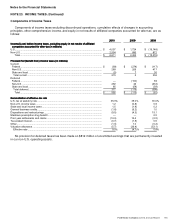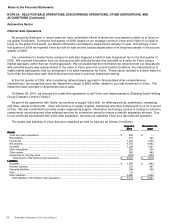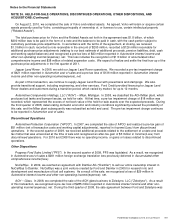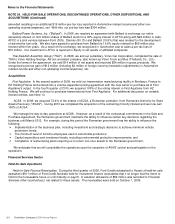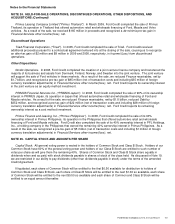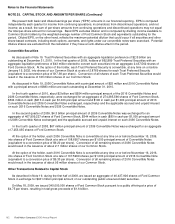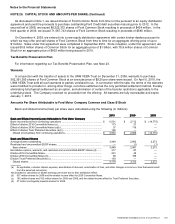Ford 2010 Annual Report Download - page 156
Download and view the complete annual report
Please find page 156 of the 2010 Ford annual report below. You can navigate through the pages in the report by either clicking on the pages listed below, or by using the keyword search tool below to find specific information within the annual report.
Notes to the Financial Statements
154 Ford Motor Company | 2010 Annual Report
NOTE 22. EMPLOYEE SEPARATION ACTIONS (Continued)
Other Employee Separation Actions. The following table shows pre-tax charges for other hourly and salaried employee
separation actions, which are recorded in Automotive cost of sales and Selling, administrative and other expenses
(in millions):
2010
20102010
2010
2009
20092009
2009
2008
20082008
2008
Ford Europe................................................................................................
................................
$ 56 $ 109 $ 38
Ford North America (U.S. salaried-related) ................................................................
................................
31 105 184
Ford South America ................................................................................................
................................
3 20 —
Ford Asia Pacific Africa................................................................
................................
1 17 91
The charges above exclude costs for pension and OPEB.
Financial Services Sector
Separation Actions
In the first quarter of 2010, Ford Credit announced plans to restructure its U.S. operations to meet changing business
conditions, including the decline in its receivables. In 2010, 2009, and 2008, Ford Credit recognized pre-tax charges of
$33 million, $64 million, and $16 million, respectively, in Selling, administrative and other expenses for separation actions.
These charges exclude pension costs.
NOTE 23. INCOME TAXES
Income Taxes
In accordance with U.S. GAAP, we have elected to recognize accrued interest related to unrecognized tax benefits and
tax-related penalties in the Provision for/(Benefit from) income taxes on our consolidated statement of operations.
Valuation of Deferred Tax Assets and Liabilities
Deferred tax assets and liabilities are recognized based on the future tax consequences attributable to temporary
differences that exist between the financial statement carrying value of assets and liabilities and their respective tax
bases, and operating loss and tax credit carryforwards on a taxing jurisdiction basis. We measure deferred tax assets
and liabilities using enacted tax rates that will apply in the years in which we expect the temporary differences to be
recovered or paid.
Our accounting for deferred tax consequences represents our best estimate of the likely future tax consequences of
events that have been recognized in our financial statements or tax returns and their future probability. In assessing the
need for a valuation allowance, we consider both positive and negative evidence related to the likelihood of realization of
the deferred tax assets. If, based on the weight of available evidence, it is more likely than not that the deferred tax
assets will not be realized, we record a valuation allowance.













